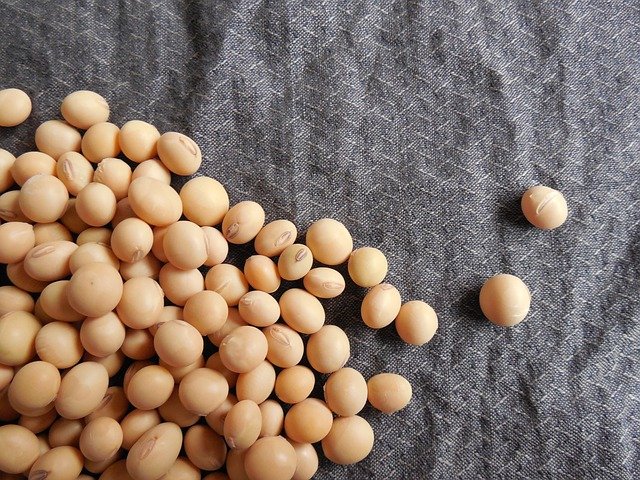
Soy is a legume rich in beneficial properties: it lowers cholesterol, is good for the nervous system, intestines, etc… Let’s find out what are the properties of soy and any contraindications.
Of Asian origin, this legume was grown for food over 5000 years ago. The properties of soy were already known to the Chinese, so much so that it was included in the first medical book we know of: the Pen Tsao Gong Mo. Soy, as already mentioned, is a plant belonging to the legume family, it has an erect stem that can reach 80/90 cm in height and the fruits are flat pods, similar to our peas.
There are several types of soy: yellow, black, red and green. As for red soybeans and green soybeans, it should be emphasized that they are azuki beans and mung beans respectively and both do not belong to the same botanical species as yellow soybeans (the Glycine max plant, which we typically identify as “soy”).
In addition, bean sprouts are obtained from green soybeans. The soy beans harvested unripe and boiled for a few minutes in water or steamed, on the other hand, are called edamame.
Soya can be consumed in different preparations and in different forms (beans, sprouts, drinks…), the important thing is that it is cooked and treated as the consumption of raw soy would be toxic due to the presence of anti-nutritional substances (i phytates), i.e. molecules that interfere with the absorption of nutrients by our body.
What are soy based foods
Today many derivatives of this legume are used: soy sauce, soy sprouts, soy milk, soy flour, from which as many varieties of food products are derived. Specifically, the best known and most consumed soy-based products are:
- Edamame: preparation based on unripe soy beans cooked in water;
- Tempeh: fermented derivative of yellow soy and prepared with the addition of the Rhizopus oligosporus mushroom;
- Tofu: curd derivative of soy;
- Miso: fermented condiment made with soy beans;
- Natto: condiment produced with soy beans cooked and fermented with bacillus subtilis.
Most of the soybean grown worldwide is used for the production of soybean oil, while its waste product (what remains after the fat part of the soy has been extracted) is mainly used in the livestock sector for livestock feed and, of this, only a part is further processed for the production of soy protein isolate. Now let’s see what are the nutritional values of soy.
Soy: calories and nutritional values
Soy has 446 calories per 100 grams. It is a food particularly rich in high biological value proteins, minerals and, like all legumes, it provides a good amount of fiber, useful for the well-being of the intestine. Soy also contains some vitamins such as those of group B. The guidelines recommend that you include legumes in your diet at least 2 or 3 times a week, to limit the consumption of meat. Below is a summary table of the nutritional values of this legume.
Nutritional values per 100g of soy:
- Waterfall: 8.54 g
- kcal: 446
- Proteins: 36.49 g
- Fat: 19.94 g
- of which saturated: 2.884 g
- Carbohydrates: 30.16 g
- of which sugars: 7.33 g
- Fibers: 9.3 g
- Soccer: 277 mg
- Glycemic index: 15
- Cholesterol: 0 g
Soy: properties and benefits
Soy contains a wide range of important nutrients: manganese, selenium, copper, potassium, phosphorus, magnesium, iron, calcium, vitamin B6, folic acid, riboflavin (B2), thiamine (B1) and vitamin K. It is also, a good source of protein (37%), but it should be noted that processing soy at high temperatures can denature some of the proteins and reduce their quality!
Soybeans also contain fats (20%), the latter mainly consisting of unsaturated fatty acids which play a fundamental role for our organism: in fact, they carry out a preventive action against numerous alterations and diseases.
Soy also contains fiber, which helps fight constipation, regulates blood sugar and helps normalize the level of cholesterol in the blood.
Soy, in addition to providing a high nutritional content, is also able to exert various beneficial effects on our body.
It has been shown that soy lowers cholesterol, promotes bone mineralization by preventing osteoporosis, helps the digestive system in the case of a lazy bowel , and helps prevent cancer. Furthermore, the presence of isoflavones gives soy beneficial qualities against menopausal disorders. This is because isoflavones help replenish some of the estrogen no longer produced by the ovaries.
Always the isoflavones, also seem to improve blood pressure, glycemic control and inflammation in general, thus preventing various disorders associated with it. Still, these molecules appear to help with bone fragility that occurs after menopause.
How much soy to eat
Soy is distinguished from other legumes for its higher protein and fat content. The recommended serving is 50g of dry soy which provides 220 kcal of which 18.5g of protein, 9.6g of fat, 11.6g of carbohydrates and 6g of fiber. Alternatively, the recommended serving of canned or fresh soy is 150 grams.
The ideal is to always maintain a varied diet of all animal and vegetable protein sources, therefore its consumption can be inserted once or twice a week as an alternative to other legumes or in place of meat or fish.
Soy: some tips for using it in the kitchen
The dry soybean pods need about 12 hours to soak and then to cook for about 2 hours. Soy can be used on its own, as a simple soup or cream; it can also be used to enrich salads or to make soups with vegetables, other legumes and / or cereals. Soy is also suitable for more particular preparations such as burgers or vegetable meatballs.
Dried beans are also used to prepare soy milk consumed more and more often not only by vegans but also by those who are lactose intolerant as a substitute for cow’s milk, but also as an ingredient in sweets, mayonnaise or bechamel. Finally, remember that in the kitchen it is also possible to use soy derivatives such as tofu, bean sprouts, soy sauce and tempeh.
Soy lecithin
Among the most important components of soy, we must mention soy lecithin, an emulsifying substance contained in soy and widely used as a thickener in the production of creams and fillings. Soy lecithin is rich in omega-3, omega-6, choline, inositol and minerals such as iron, calcium and phosphorus. One of the main properties of soy lecithin is to lower cholesterol in the body.
Contraindications of Soy
Soy has no particular contraindications, as long as it is not used recklessly. Excessive use of soy, in fact, can lead to allergies or annoying gastrointestinal disorders. The intake of soy and extracts containing isoflavones (phytoestrogens contained in soy) is not recommended for those who have suffered from hormone-dependent cancer (for example breast or uterus).
Even during pregnancy it is good to take soy in moderation and it is not recommended to administer it to newborns. In case you are taking soy isoflavone based supplements, it is advisable not to exceed the dose of 80 mg per day. If you take soy lecithin tablets it is recommended not to exceed 2.5 / 3 grams per day (unless otherwise indicated by your doctor or pharmacist).
However, the greatest danger in the use of this legume today is constituted by GMOs, which comprises almost 90% of all the soy produced! Therefore always choose soy from organic crops. Furthermore, as we said at the beginning of this article, it is important to know that raw soy, like other legumes, contains substances called “antinutrients” that inhibit the absorption of the precious nutrients it contains. This problem is solved by subjecting the legume to a temperature above 85 ° C.
Soy and thyroid
Is there a correlation between soy and hypothyroidism? Indeed, the excessive consumption of soy is associated with a condition of hypothyroidism, characterized by a low production of thyroid hormones. This would be attributable to soy isoflavones, which have shown goitrogenic action, i.e. an interference action in iodine metabolism and in the synthesis of thyroid hormones. Symptoms of this problem consist of discomfort, sleepiness, constipation and an enlarged thyroid.
However, it should be noted that most studies conducted on healthy adults have found no significant link between soy consumption and changes in thyroid function. Therefore, the problem seems to be limited to a small number of particularly “sensitive” people.
In any case, caution is recommended in the consumption of soy in case of hypothyroidism. For any doubts, always ask your doctor for advice.






